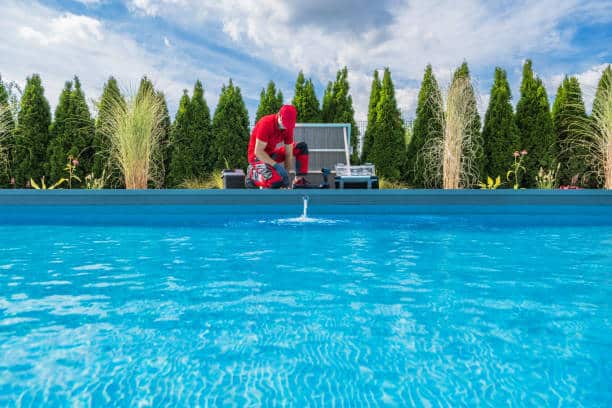How to raise the pH in the pool is a crucial aspect of maintaining your swimming oasis. Pool chemistry is vital for safe and enjoyable swimming. A well-balanced pool protects against harmful bacteria and enhances swimmer comfort.
The Importance of pH Levels
Understanding pH levels in your pool is essential. This measure indicates how acidic or alkaline your water is. A balanced pH is key to preventing damage to pool equipment and ensuring swimmer safety.
Common Low pH Challenges
Low pH levels can lead to several problems. These include corrosion of pool equipment, skin irritation, and a less effective sanitation process. It’s important to regularly monitor and adjust your pool’s pH to avoid these issues.
In summary, managing pool chemistry, especially pH levels, is fundamental. It ensures a safe and enjoyable swimming environment.
Understanding pH Levels in Pools
Maintaining the right pH level is key in pool care. When learning how to raise pH in pool, it’s important to grasp what pH levels mean.
What pH Levels Represent
pH levels in a pool range from 0 to 14. This scale shows how acidic or alkaline your pool water is. A level below 7 indicates acidity, while above 7 is alkaline.
Ideal pH Range for Pools
The best pH range for pools is between 7.2 and 7.8. This range ensures optimal swimmer comfort and effective chlorine function.
Causes of pH Imbalance
Several factors can lower pH levels. These include rainwater, organic material, and pool usage. Recognizing these causes helps in effectively managing pH levels.
In summary, understanding pH levels aids in better pool maintenance. Knowing the causes of imbalance is crucial in learning how to raise the pH in the pool.
How to Raise PH in Pool
Learning how to raise the pH in the pool is crucial for maintaining water quality. Here’s a simple guide.
Testing and Interpreting pH Levels
First, test your pool’s pH level using a reliable test kit. This will guide your next steps.
Raising pH Levels
To increase pH, you can use soda ash (sodium carbonate) or baking soda (sodium bicarbonate). Follow these steps:
- Determine the required amount based on your pool’s volume and current pH.
- Dissolve the chemical in a bucket of water.
- Pour the solution into the pool, distributing it evenly.
Safety Precautions
Always wear protective gear when handling chemicals. Follow the manufacturer’s instructions carefully.
By understanding these methods, you can effectively learn how to raise pH in pool. Regular checks and adjustments are key to maintaining optimal water quality.
Maintaining a Balanced Pool Chemistry
After mastering how to raise pH in pool, focus on maintaining this balance. Regular upkeep ensures a healthy pool environment.
Regular Monitoring
Consistently check your pool’s pH level. Aim for weekly tests. This helps in making timely adjustments.
Preventing Fluctuations
To prevent pH swings:
- Keep the pool clean from debris.
- Manage the pool’s chlorine levels.
- Cover the pool when not in use.
A Holistic Approach
Remember, pH is just one part of pool care. Also, monitor alkalinity and sanitizer levels. Balance is key in all aspects.
Conclusion
In summary, understanding and managing your pool’s pH level is essential for maintaining a safe and enjoyable swimming environment. From learning how to raise pH in pool to regular maintenance, each step is vital. Regular testing, using the right chemicals, and understanding the factors affecting pH levels are key to achieving and maintaining the perfect balance.
This not only ensures the health and longevity of your pool but also provides a pleasant swimming experience. Remember, a well-maintained pool is a source of joy and relaxation, so investing time in understanding and caring for your pool’s chemistry pays off in the long run.
Embrace these practices to keep your pool inviting, safe, and sparkling clean throughout the swimming season.
Frequently Asked Questions
Test your pool’s pH level at least once a week. More frequent testing is recommended during heavy use or after significant rainfall.
The ideal pH level for a pool is between 7.2 and 7.8. This range ensures effective chlorine use and swimmer comfort.
Yes, baking soda can be used to raise the pH level in pools. It’s a milder option compared to soda ash.
Yes, rainwater can lower the pH level of your pool, as it’s usually slightly acidic. It’s important to check and adjust the pH after heavy rain.
References
How to Raise the pH in a Pool – www.thespruce.com
Read Also
- How to Store Cilantro: Herb Preservation Techniques
- How to Sell Your Soul: Metaphorical Decision-Making Exploration
- How to Clean Cuisinart Coffee Maker: Appliance Maintenance Skill
- How to Change Name on iPhone: Personalization of Technology
- How to Change Language on Disney Plus: Streaming Service Customization






